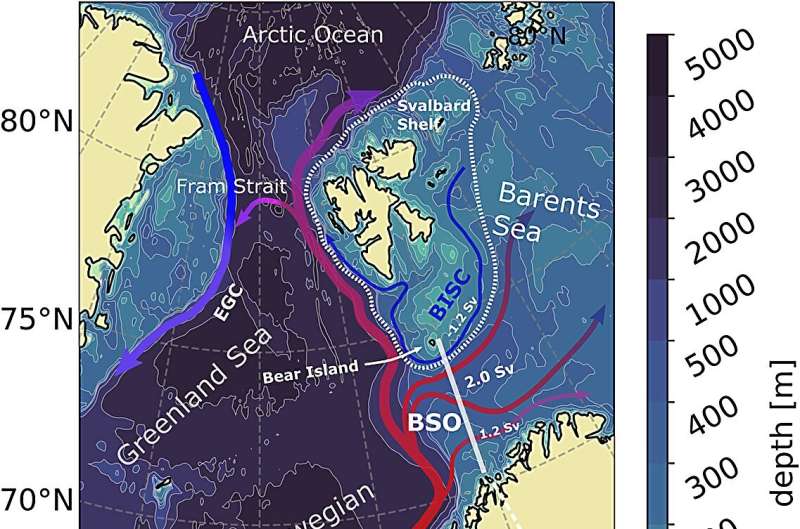This article has been reviewed according to Science X's editorial process and policies. Editors have highlighted the following attributes while ensuring the content's credibility:
fact-checked
peer-reviewed publication
trusted source
proofread
Riddle of varying warm water inflow in the Arctic now solved

In the "weather kitchen," the interplay between the Azores High and Icelandic Low has a substantial effect on how much warm water the Atlantic transports to the Arctic along the Norwegian coast. But this rhythm can be thrown off for years at a time.
Experts from the Alfred Wegener Institute finally have an explanation for why: Due to unusual atmospheric pressure conditions over the North Atlantic, low-pressure areas are diverted from their usual track, which disrupts the coupling between the Azores High, the Icelandic Low and the winds off the Norwegian coast. This finding is an important step toward refining climate models.
In winter, the Norwegian coast is normally home to harsh conditions: The wind blows out of the southwest for days or even weeks at a time. Low-pressure areas make their way along the coast and not only bring rain and snow with them; the winds they produce determine how much warm water the Atlantic transports from southerly latitudes to the Barents Sea and the Arctic. Yet this flow of warm water can vary.
Climate researchers want to take a closer look at these fluctuations so that their computer models can better predict how Arctic sea-ice extent will change over the next several decades. The problem: We still don't completely understand the cause of these fluctuations in the complex air and ocean currents off the coast of Norway and in the Barents Sea. But doing so is essential to further improving climate models.
Temporary decoupling
A team led by oceanographer Finn Heukamp from the Alfred Wegener Institute, Helmholtz Center for Polar and Marine Research (AWI) has just published a study in the journal Communications Earth & Environment, in which he and his colleagues investigated ocean currents along the Norwegian coast and into the Barents Sea. Their focus was on the atmospheric pressure difference between the Azores High and the Icelandic Low, also known as the North Atlantic Oscillation (NAO), which shapes the currents off of Norway.
They were particularly interested in the question of why there are (in some cases, extreme) deviations from the typical interplay between the NAO and weather conditions. Normally, the intensity of the winds and therefore the ocean currents is predominantly determined by the atmospheric pressure difference in the NAO.
When the NAO is more pronounced, it creates powerful air currents, which drive low-pressure areas across the North Atlantic and past Norway on their way north. When the atmospheric pressure difference lessens, both the winds and the low-pressure areas run out of momentum.
As such, the NAO, the low-pressure areas' track, and the intensity of the ocean currents off the coast of Norway are normally closely interconnected. However, a decoupling of the NAO and ocean currents was observed in the Barents Sea as far back as the late 1990s.
"This unusual decoupling frequently manifested in winter between the years 1995 and 2005," says Heukamp. "But the cause of these changes was unclear." Thanks to a mathematical ocean model that simulates the Arctic Ocean at very high resolution, the experts now have the answer.
Apparently, the phenomenon is caused by an unusual change in the low-pressure areas' track. Heukamp has now determined that the stream of low-pressure areas that pass by Norway, moving from the southwest to the north, is at times disrupted by powerful, nearly stationary high-pressure areas, also known as blocking highs. The latter push the fast-moving low-pressure areas out of their normal track. As a result, the NAO and the northward flow of warm water are temporarily decoupled.
Refining climate models
"At the moment, we still can't say how often this type of situation arises—for instance, if it repeats every few decades—because the observational data we use to compare with our ocean model only goes back roughly 40 years," says Heukamp. Nevertheless, the findings are very important for climate modeling.
"Global climate models simulate on a comparatively broad scale," the researcher explains. "With the latest results from our high-resolution analysis for the North Atlantic and the Arctic, we've now added an important detail for making climate modeling for the Arctic even more accurate." They also show that, in future, the NAO, the low-pressure areas over the Atlantic, and the ocean currents need to increasingly be viewed together.
Given that both the transport of warm water and the track of lows over the Atlantic affect our weather in the middle latitudes, the results are also interesting in terms of more accurately predicting the future climate and weather in Central Europe.
More information: Finn Ole Heukamp et al, Cyclones modulate the control of the North Atlantic Oscillation on transports into the Barents Sea, Communications Earth & Environment (2023). DOI: 10.1038/s43247-023-00985-1. www.nature.com/articles/s43247-023-00985-1
Journal information: Communications Earth & Environment
Provided by Helmholtz Association of German Research Centres




















